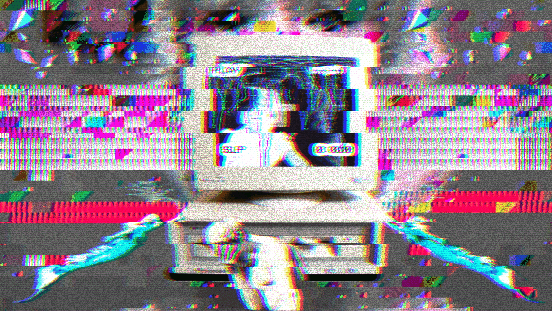
The dominant, continuing search for a noiseless channel has been, and will always be no more than a regrettable, ill-fated dogma. E v e n t h o u g h t h e c o n s t a n t s e a r c h f o r c o m p l e t e transparency brings newer, ‘better’ media, every one of these new and improved techniques will always have their own fingerprints of imperfection. While most people experience these fingerprints as negative (and sometimes even as accidents) I emphasize the positive consequences of these imperfections by showing the new opportunities they facilitate.
In the beginning there was only noise. Then the artist moved from the grain of celluloid to the magnetic distortion and scanning lines of the cathode ray tube. he wandered the planes of phosphor burn-in, rubbed away dead pixels and now makes performance art based on the cracking of LCD screens. The elitist discourse of the upgrade is a dogma widely pursued by the naive victims of a persistent upgrade culture. The consumer only has to dial #1-800 to stay on top of the technological curve, t h e w a v e s o f b o t h e u p h o r i a a n d disappointment. It has become normal that in t h e f u t u r e t h e consumer will pay less for a device that c a n d o m o r e . T h e user has to realize that improving is nothing more than a proprietary protocol, a deluded consumer myth about progression towards a holy g r a i l of perfection.
Dispute the operating templates of creative practice by fighting genres and expectations! I feel stuck in the membranes of knowledge, governed by social conventions and acceptances. As an artist I strive to reposition these membranes; I do not feel locked into one medium or between contradictions like real vs. virtual or digital vs. analog. I surf the waves of technology, the art of artifacts. The quest for complete transparency has changed the computer system into a highly complex assemblage that is often hard to penetrate and sometimes even completely closed off. This system consists of layers of obfuscated protocols that find their origin in ideologies, economies, political hierarchies and social conventions, which are subsequently operated by different actors.
Some artists set out to elucidate and deconstruct the hierarchies of these systems of assemblage. They do not work in (binary) opposition to what is inside the flows (the normal uses of the computer) but practice on the border of these flows. Sometimes, they use the computers’ inherent maxims as a façade, to trick the audience into a flow of certain expectation that the artwork subsequently rapidly breaks out of. As a result, the spectator is forced to acknowledge that the use of the computer is based on a genealogy of conventions, while in reality the computer is a machine that can be bend or used in many different ways. With the creation of breaks within politics and social and economical conventions, the audience may become aware of the preprogrammed patterns. Now, a distributed awareness of a new interaction gestalt can take form.
away from the established action scripts and join the avant-garde of the unknown.
Become a nomad of noise artifacts! There are three occasions in which the static, linear notion of transmitting information can be interrupted. I use these instances to exploit noise artifacts, that I sub-divide as glitch, encoding / decoding (of which compression is the most ordinary form) and feedback artifacts. Etymologically, the term “noise” refers to states of aggression, alarm and powerful sound phenomena in nature ('rauschen'), such as storm, thunder and the roaring sea. But when noise is explored within a social context, the term is often used as a figure of speech and as such has many more meanings. Sometimes, noise stands for unaccepted sounds: not music, not valid information or what is not a message. Noise can also stand for a (often undesirable, unwanted, other and unordered) disturbance, break or addition within the signal of useful data. Here noise exists within the void opposite to what (already) has a meaning. Whichever way noise is defined, the negative definition also has a positive consequence: it helps by (re)defining its opposite (the world of meaning, the norm, regulation, goodness, beauty and so on). Noise thus exists as a p a r a d o x ; w h i l e i t i s o f t e n negatively defined, it is also a positive, generative quality (that is present in any communication medium). The voids generated by a break are not only a lack of meaning, but also powers that force the reader to move away from the traditional discourse around the technology, and to open it up. Through these voids, artists and s p e c t a t o r s c a n understand the politics behind the code and voice a critique towards the digital media. It can be a source for new patterns, anti-patterns and new possibilities that often exist on the border or membrane (of for instance language).